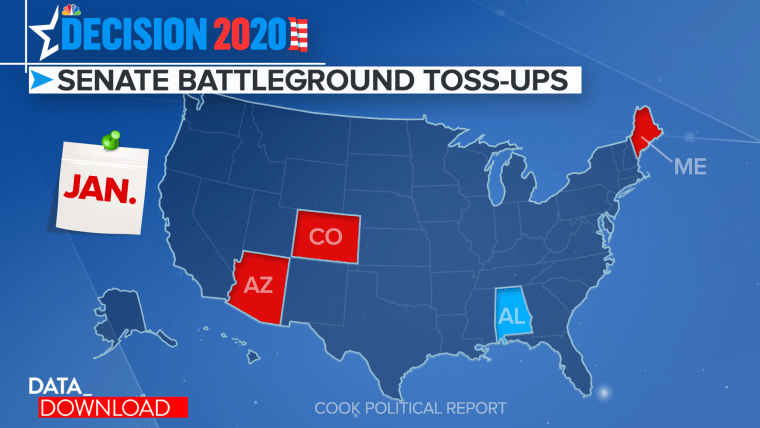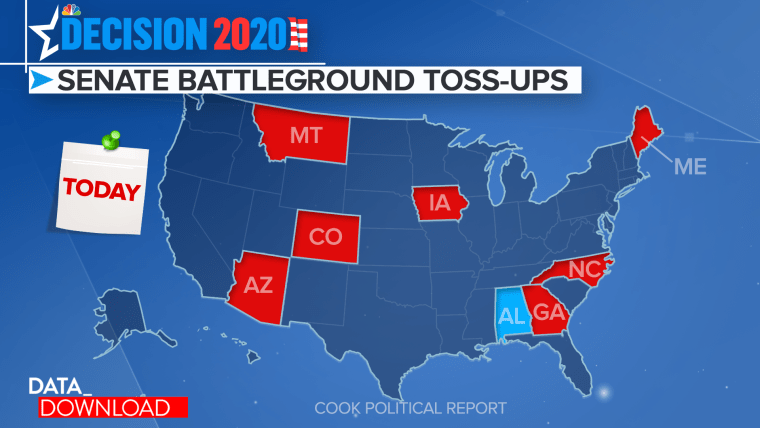WASHINGTON — Amid the constant political chaos of 2020, there have been a few consistencies. One of them has been a growing Democratic advantage in this fall’s congressional races, particularly the Senate.
For Democrats, the potential for pickups is growing and affecting some places where a tight general election race is not a normal occurrence. From the Mountain West to the South, the list of competitive Senate races for the GOP looks different this year.
Going into this election cycle Republicans knew they were going to be defending a challenging map. There are 23 Republican seats on the ballot this fall and only 12 for the Democrats. But aside from those differences, the changes in battlegrounds since the beginning of the year have been remarkably one-sided.
In January — when the Cook Political Report released its first race ratings for the year — it showed three Republican seats that were rated “Toss Up” or worse, while Democrats had one seat that was “Toss Up” or worse.

In that list of ratings, Republican seats in Arizona, Colorado and Maine were listed as “Toss Ups.” In addition, the GOP had seats in Kansas and North Carolina that were listed as “Lean Republican.” For the Democrats, their seat in Alabama was listed as a “Toss Up.” They had one additional seat in Michigan listed as “Lean Democratic.”
The battleground races largely made sense.
The Republican “Toss Up” states, Colorado and Maine, went to Democratic presidential candidate Hillary Clinton in 2016. And Arizona’s other Senate seat had just flipped Democratic in 2018. In the GOP’s “Lean” seats, North Carolina’s statewide contests have been close for the past several cycles. And Kansas looked like a bit of an outlier, but the state had just elected a Democratic governor.
For the Democrats, it made sense that Alabama was at least a “Toss Up” since the state is usually solidly Republican. Democratic Sen. Doug Jones won his race against a deeply flawed candidate in Roy Moore. And Michigan, the home of the Democratic “Lean” seat, voted for Donald Trump in 2016.
But the latest Cook ratings now show a different landscape. For the Republicans, seven Senate seats are highly competitive, rated “Toss Up” or worse, and still only one Democratic seat falls into that category.

For the Democrats, the only difference is the Alabama seat has moved to “Lean Republican.” The Democrats “Lean” seat in Michigan remains in the same category.
For the Republicans, however, the changes are more dramatic. The Colorado and Arizona seats have moved from “Toss Up” to “Lean Democratic.” And there are now five GOP “Toss Up” seats including those in Iowa, Georgia, Montana and North Carolina — all states won by Trump in 2016 — along with Maine.
In addition, there are three “Lean Republican” seats, including the other Georgia seat, Kansas and South Carolina. Trump won all those states by 5 points or more in 2016.
And a few of those new Republican “Lean” states stand out for being battlegrounds. Consider South Carolina and Kansas.
In some ways, Sen. Lindsey Graham’s seat in South Carolina tells the most dramatic story for 2020. It has moved a long way since January in the Cook ratings. Back then the seat was listed as “Solid Republican,” in part because Graham seemed to be working hard to win over Trump voters. The president won the state by 14 points in 2016 and no Democrat had won a Senate seat in the state for 15 years.
But the numbers show much less support for Graham recently. A late-September poll from Quinnipiac University found the race dead even and every poll since September has it in single-digits. Furthermore, Graham’s opponent, Jaime Harrison, is flooding the airwaves with campaign ads, and is set to outspend Graham 7 to 1 in the last month of the election.
The close race for the open Kansas seat may tell a longer story of change. It has not elected a Democrat to the Senate since 1939 and the 20-point win the state gave Trump in 2016 was largely in line with other recent GOP presidential wins there.
But when Kansas elected a Democratic governor in 2018, the results felt like pushback against the previous eight years of Republican rule. That time brought large-scale tax cuts and program cuts to the state — including heavy cuts to schools. And now the latest polls in the state suggest the race is close.
One survey from a Republican firm found the Republican, Roger Marshall, leading by about 4 points. A survey from a Democratic firm found the Democrat, Barbara Bollier, leading by 2. Both polls had Marshall at 43 percent, which is not where a Republican wants to be in Kansas, especially not a month out from Election Day.
The presidential race has dominated the news this past week — and really the entire cycle. Years with presidential races tend to be that way and Trump has only heightened the effect.
But the Senate ratings shift serve as a reminder that there is more at stake in November than just the White House. And the last few months have shown a decided Democratic tilt on the other end of Pennsylvania Avenue, some of it coming from places we don’t usually expect.